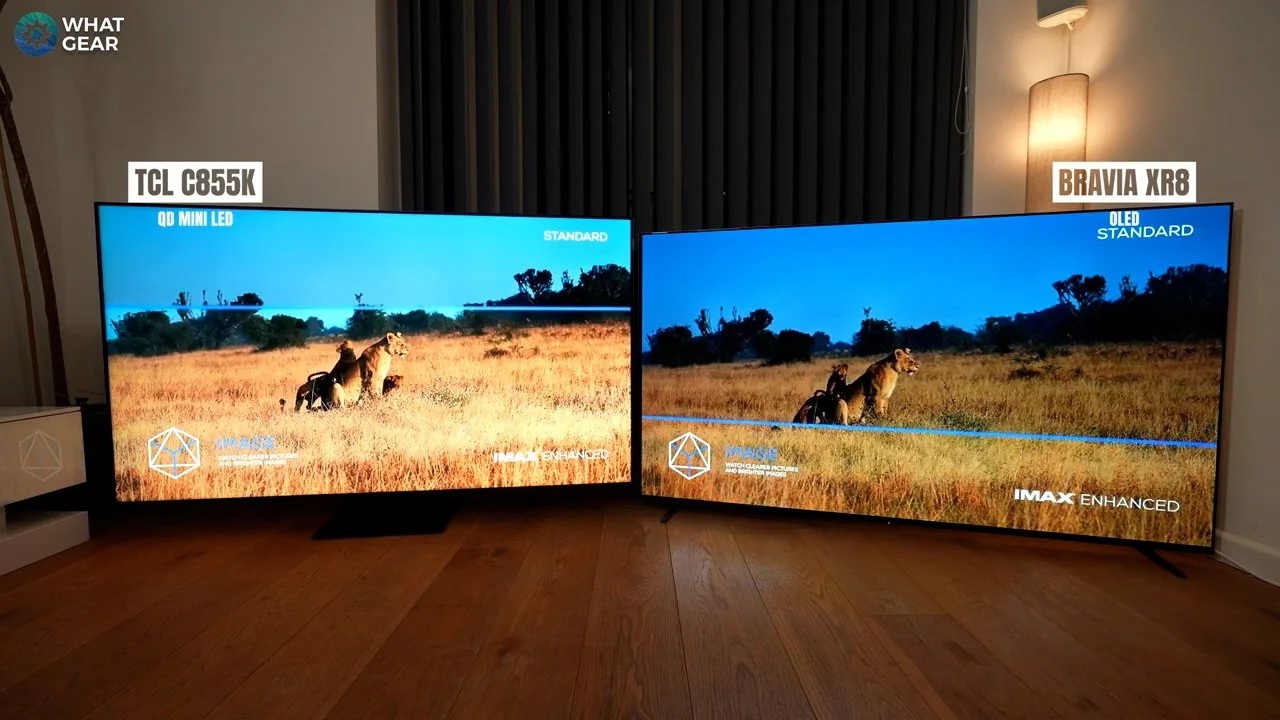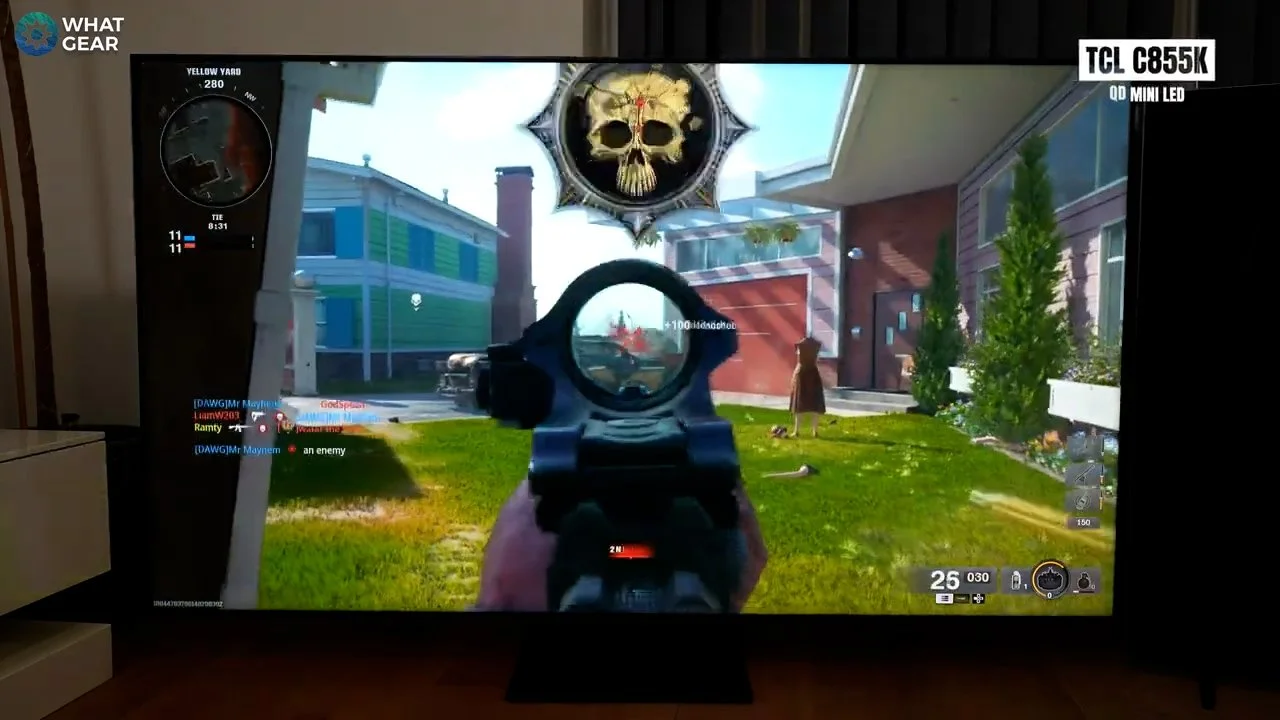OLED TV vs Mini-LED Comparison ( TCL C855K vs Sony Bravia XR8 )
Welcome to WhatGear reviews. Today, I'm comparing what might be the ultimate value champ in the world of QLED Mini LED TVs, The TCL C855K vs the very formidable Bravia XR8 OLED from Sony.
Surprisingly, there are many similarities between these two, but there are certainly some huge differences that you need to know about. And by the end of this video, you will. Both models are 65" Smart TVs running on the Google TV operating system. But let's focus on the differences.
Picture Quality
So, a significant difference is, of course, the panel technology. The TCL uses a Mini LED Backlighting system with 1344 local dimming zones & it has a Quantum Dot layer for those rich colours. The Bravia XR 8 is an OLED, which means each Pixel can be controlled individually. There are pros and cons on both sides here.
For example, Mini LED panels tend to live longer and can get much brighter than most OLED panels. The TCL C855K can reach up to 3500 nits & Bravia just under 1000 nits.
However, OLEDs offer near infinite contrast levels and visibly no light blooming thanks to the precise control of each Pixel. But of course, one drawback is the possibility of screen burn-in. Which is basically impossible to repair
Side by side, the picture quality at first glance is comparable in colours straight out of the box. And both look amazing in this area and can look even better if you calibrate them professionally. In terms of colour accuracy, the Sony supports an impressive 99.4% of the DCi P3 colour Gamut & the TCL supports 97%.
But if you're pixel-peeping the differences, the attributes I just mentioned will be noticeable. Better Darkness on the Bravia & Much better brightness on the TCL. That might be one of the reasons why the C855K has achieved its 4K HDR PREMIUM 3300 rating.
That's not to say TCL isn't good at creating deep black with its Mini LED zones… It's actually surprisingly good. And that's probably why Sony's flagship model this year is a Mini LED. Both TVs support Dolby Vision, and both are certified by IMAX Enhanced. This means that it is tested by and meets the standards of IMAX and DTS Hollywood experts. So you will be satisfied with both TVs when watching movie content.
The viewing angles on both TVs are excellent. You won’t notice significant colour shifts if you're sitting at a very obscure angle.
Sound Quality
Here's where things differ quite a bit. It's the built-in audio. TCL partnered with ONKYO, a Japanese audio company, to create speakers. It uses a 2.2.2 speaker setup at a combined 60 watts, And it also has an integrated 20Watt Sub-woofer on the back.
The Bravia XR8 uses a 2.1 50W speaker setup, but interestingly, this is placed behind the glass. Sony calls this acoustic surface audio. A feature on the Sony allows you to use the TV as a central channel when combined with a Sony soundbar.
So you have more speakers and power on the TCL and the interesting Acoustic Surface speakers on the Sony.
Intelligent Features
Now, when it comes to the UI. The fact that both TVs run on the GOOGLE TV platforms means. They're almost identical. You can access Google Assistant all the same apps on the PlayStore. So you will be satisfied with both TVs in terms of available apps.Both support Chromecast, Google Home, Apple AirPlay, Apple Home Kit, and Alexa.
Only when you dive into the settings menus will you notice some differences, particularly in the picture and audio settings menus.
The Bravia has excellent image upscaling software built, which is great for lower-resolution content. The TCL also has a 120 Hz de judder, deblur, and 240 Hz motion acceleration feature. So, software is an area that's closely contested.
Gaming Features
Now, here's where things get interesting…well, for me anyway. If gaming is important to you, some significant differences exist between the TCL and the Bravia.
But first, the similarities. They both support VRR, ALLM, and both can deliver a 4K 120Hz picture. However, input latency, essential to competitive gamers, is slightly different.
The input response of the Bravia XR8 with a 4K 120 input signal is a respectable 5.1 milliseconds, the TCL 5.7 milliseconds. So, we are talking about fractions of a millisecond here. So you'll have to decide whether that would be worth paying more for.
When testing, both of these TVs are out. The gameplay is fast and smooth, and both handle the PS5 Pro well. So no complaints from me.
Each TV has its own dedicated gaming settings menu. This gives you access to gaming-specific tools designed to give you an advantage over the competition. However, a little edge for the TCL versus this specific Bravia is the brightness, particularly in darker games. Sony also supports True Tone mapping, which comes into play when paired with a PlayStation.
It is worth noting that TCL has gone the extra mile to get the Gsync and Freesync premium pro, which is good news for PC gamers. Also, the TCL supports 1440P, whereas Bravia does not.
Connectivity and Design
Now, let's look at the difference between the IO. The ports on the back. The Bravia has everything you'd need: 4 HDMI, 2 USB, one of which is USB 3.0. You also get an IR extender port, satellite input, analog audio, and optical out. Compared to the TCL, the slight downside is that only two of the four HDMI ports support HDMI 2.1. This means you can only connect up to two 4K 120Hz inputs.
The TCL has a similar setup as the Bravia, but all the HDMI ports support HDMI 2.1, and one supports up to 144Hz input. It also has a feature that I'm sure many people will appreciate: its easy-access USB port hidden behind the bottom right corner of the display.
Price and Value
This is the most significant difference between these two very impressive TVs. It is the price. Sony has been in the European TV & American TV market for a long time, and they're well known for their premium build quality and excellent colour reproduction and upscaling technology. Because of that, they charge quite a bit more than the competition. The Bravia XR8 OLED at the time of this video is £1999 here in the UK.
On the other hand, TCL is 2nd leading TV brand in the world in terms of sales. And because they're not as well known in these new markets. This is excellent news for you because their prices are incredibly competitive. The TCL C855K at the time of this video is £750 less than the Sony.
Conclusion
So when it comes to deciding between these two. Your budget is a significant factor. Let's say you were only looking to spend around a thousand pounds. In that scenario, stretching to £1250, it will be worth 100% of every penny, in my opinion. You'll get an amazingly bright picture, impressive black levels, super fast refresh rates, fantastic IO, and built-in speakers.
If money is not a concern, then with Bravia XR8, you get those infinite blacks, all the advantages of OLED tech, Sony's impressive X reality upscaling, the Triluminos colour reproduction, and those very interesting speakers behind the glass.
But maybe, if your budget is £2000, the Sony would be a fantastic OLED option, but, of course, in that scenario, you could consider saving the £750 and get the TCL and PS5 Pro to go with it for the same price. Ultimately, the choice is yours. So let me know if someone handed you £2000 to spend on a TV right now. Which option would you go for?































